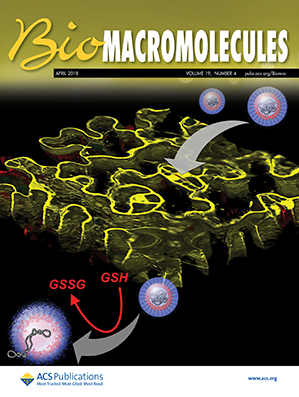Plasticity of 3D Hydrogels Predicts Cell Biological Behavior
IF 5.4
2区 化学
Q1 BIOCHEMISTRY & MOLECULAR BIOLOGY
引用次数: 0
Abstract
Under 3D culture conditions, cells tend to spread, migrate, and proliferate better in more viscoelastic and plastic hydrogels. Here, we present evidence that the improved cell behavior is facilitated by the lower steric hindrance of a more viscoelastic and plastic matrix with weaker intermolecular bonds. To determine intermolecular bond stability, we slowly insert semispherical tipped needles (100–700 μm diameter) into alginate dialdehyde-gelatin hydrogels and measure stiffness, yield strength, plasticity, and the force at which the surface ruptures (puncture force). To tune these material properties without affecting matrix stiffness, we precross-link the hydrogels with CaCl2 droplets prior to mixing in NIH/3T3 fibroblasts and final cross-linking with CaCl2. Precross-linking introduces microscopic weak spots in the hydrogel, increases plasticity, and decreases puncture force and yield strength. Fibroblasts spread and migrate better in precross-linked hydrogels, demonstrating that intermolecular bond stability is a critical determinant of cell behavior under 3D culture conditions.
- Download: Download high-res image (86KB)
- Download: Download full-size image
三维水凝胶的可塑性可预测细胞生物学行为
在三维培养条件下,细胞倾向于在粘弹性和可塑性更强的水凝胶中更好地扩散、迁移和增殖。在这里,我们提出的证据表明,粘弹性和可塑性更强、分子间键更弱的基质具有更低的立体阻碍,这有利于细胞行为的改善。为了确定分子间键的稳定性,我们将半球形尖针(直径 100-700 μm)缓慢插入海藻酸二醛-明胶水凝胶中,测量硬度、屈服强度、可塑性和表面破裂力(穿刺力)。为了在不影响基质硬度的情况下调整这些材料特性,我们在水凝胶与 NIH/3T3 成纤维细胞混合并与 CaCl2 最终交联之前,用 CaCl2 液滴进行了预交联。预交联在水凝胶中引入了微观薄弱点,增加了可塑性,降低了穿刺力和屈服强度。成纤维细胞在预交联水凝胶中的扩散和迁移效果更好,这表明分子间键的稳定性是决定细胞在三维培养条件下行为的关键因素。
本文章由计算机程序翻译,如有差异,请以英文原文为准。
求助全文
约1分钟内获得全文
求助全文
来源期刊

Biomacromolecules
化学-高分子科学
CiteScore
10.60
自引率
4.80%
发文量
417
审稿时长
1.6 months
期刊介绍:
Biomacromolecules is a leading forum for the dissemination of cutting-edge research at the interface of polymer science and biology. Submissions to Biomacromolecules should contain strong elements of innovation in terms of macromolecular design, synthesis and characterization, or in the application of polymer materials to biology and medicine.
Topics covered by Biomacromolecules include, but are not exclusively limited to: sustainable polymers, polymers based on natural and renewable resources, degradable polymers, polymer conjugates, polymeric drugs, polymers in biocatalysis, biomacromolecular assembly, biomimetic polymers, polymer-biomineral hybrids, biomimetic-polymer processing, polymer recycling, bioactive polymer surfaces, original polymer design for biomedical applications such as immunotherapy, drug delivery, gene delivery, antimicrobial applications, diagnostic imaging and biosensing, polymers in tissue engineering and regenerative medicine, polymeric scaffolds and hydrogels for cell culture and delivery.
 求助内容:
求助内容: 应助结果提醒方式:
应助结果提醒方式:


